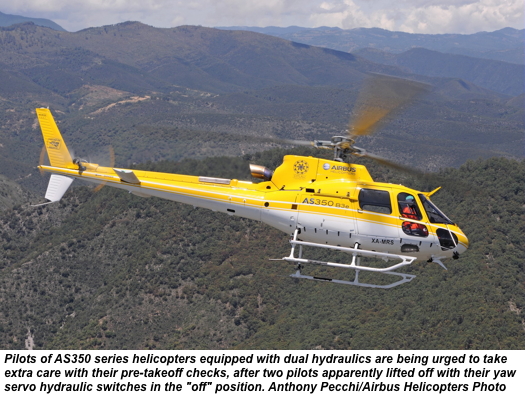
Two recent events in which pilots of AS350 series helicopters may have taken off with their yaw servo hydraulic switches in the “off” position have prompted manufacturer Airbus Helicopters to issue a safety information notice for AS350 B3, AS550 C3, and AS355/AS555 aircraft equipped with dual hydraulic systems.
Issued on Aug. 21, the safety information notice (No. 2776-S-29) does not identify the events in question, which it states are still being scrutinized by “the applicable governmental investigative authority.” According to the notice, however, available evidence indicates that the pilots in these events likely omitted the step of returning their collective-mounted yaw servo hydraulic switches from “off” to “on” during their pre-takeoff hydraulic checks.
Such an omission results in a complete lack of hydraulic boost to the tail rotor system, yet does not trigger an illumination on the caution/warning panel (CWP) on AS350 aircraft equipped with dual hydraulics. Because of the dramatically increased load required to move the yaw pedals, it is possible for the lack of hydraulic boost to be incorrectly perceived as a tail rotor control failure.
The purpose of the safety information notice is to remind pilots of AS350 B3, AS550 C3, and AS355/AS555 models equipped with dual hydraulics of the procedures and indications for the run-up hydraulic checks in these aircraft, and of the importance of strict compliance with the pre-takeoff checklist.
The difficulty in controlling yaw without hydraulic assistance on AS350 helicopters is related to the high zero pitch return moment of the increasingly large aft tail rotor blade surface area on B1 and higher models. On these aircraft, a yaw load compensator installed in parallel with the tail rotor servo actuator provides the assist required for an average pilot to control the aircraft in the event of a hydraulic system failure.
Airbus Helicopters attempted to move away from the complexity of the yaw load compensating system with the AS350 B3e, which originally incorporated additional tail rotor balancing weights in lieu of the system. However, unexpected stress on the B3e tail rotor’s laminated half-bearings resulted in a series of airworthiness directives, which ultimately required removal of the extra weights and installation of a yaw load compensator on these models.
The yaw load compensator is central to the pre-takeoff yaw servo hydraulic check on AS350 helicopters, the correct procedure for which is reiterated in the safety notice. To conduct the check on dual-hydraulic AS350 models, the pilot first switches the collective-mounted yaw servo hydraulic switch to the “off” position, which isolates the tail rotor servo control. At this stage, the yaw load compensator remains boosted by trapped hydraulic pressure, and the pilot verifies that yaw pedal loads remain relatively low.
The pilot then pushes the ACCU TST button “on,” which releases trapped hydraulic pressure through a solenoid valve, eliminating the control assistance provided by the load compensator. The pilot verifies correct operation of the solenoid valve by checking that high loads are felt on the yaw pedals.
When the pilot returns the ACCU TST button to the “off” position, the solenoid valve closes and the ACCU TST push button light extinguishes. However, the yaw load compensator is not recharged until the pilot returns the yaw servo hydraulic switch to the “on” position, at which point the pilot should confirm restoration of hydraulic pressure by checking that no loads are felt on the yaw pedals.
If a rushed or distracted pilot omits these final actions, the CWP will not illuminate unless the aircraft has been equipped with modification 07.4622, which incorporates dedicated amber caution lights for each hydraulic circuit (HYDR1 and HYDR2) and integrates a flashing mode on HYDR2 when the yaw servo hydraulic switch is turned “off.” According to the latest safety information notice, this modification has been incorporated on the new aircraft production line, and will be introduced via a service bulletin to retrofit aircraft already in operation. An Airbus Helicopters spokesperson told Vertical that this service bulletin will not be mandatory, and that “it will probably be up to the operators” to bear the expense of this safety-enhancing retrofit.
The notice indicates that Airbus Helicopters is also working on a future modification to help mitigate the possibility of leaving the ACCU TST button in the “on” position, by replacing the existing push button, with two stable positions, by a stable/momentary position push button similar in the design to the CRANK button. The company spokesperson told Vertical that the timeframe for availability of this modification has not yet been determined.
The safety information notice has been made available in its entirety on the Airbus Helicopters Inc. website.









